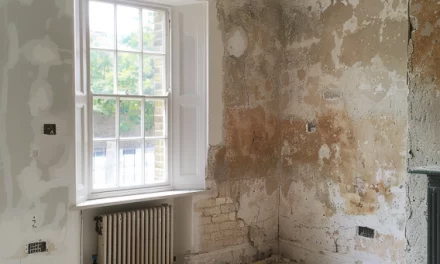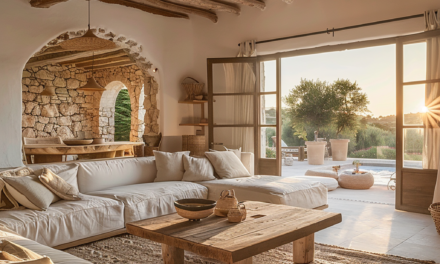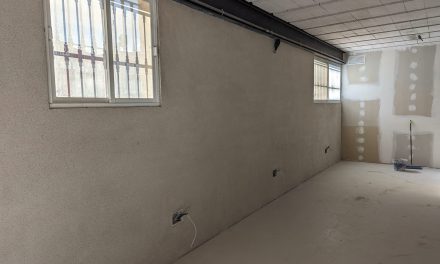In today’s fast-paced world, finding a sense of peace and tranquillity is more important than ever. With the hustle and bustle of daily life, it’s easy to feel overwhelmed and stressed. But what if there was a way to create a serene sanctuary in the comfort of your own home? A place where you can escape the chaos and unwind in nature’s embrace. In this article, we will explore how to bring peace and tranquillity into your home through the power of nature.
Creating a Natural Oasis in Your Living Space
Your living space is the heart of your home, and it’s the perfect place to start creating your natural oasis. Begin by decluttering and removing any unnecessary items that may be causing visual chaos. A minimalist approach can help create a sense of calm and open up space for nature to flourish. Consider donating or repurposing items that no longer serve a purpose.
Next, focus on incorporating natural elements into your decor. Choose furniture and accessories made from sustainable materials such as cork oak or reclaimed wood. Embrace earthy tones and textures that mimic the beauty of the outdoors. Soft, organic fabrics like linen or cotton can also add a touch of serenity to your living space.
Creating a natural oasis in your living space goes beyond just the visual aspects. Consider adding indoor plants to bring a breath of fresh air into your home. Plants not only purify the air but also have a calming effect on the mind and body. Choose a variety of plants to create depth and interest, from large leafy palms to delicate ferns.
Furthermore, incorporating natural scents can enhance the ambience of your oasis. Consider using essential oils or candles with fragrances like lavender, eucalyptus, or jasmine to evoke a sense of tranquillity and relaxation. These scents can help create a holistic experience that engages all your senses, making your living space a true sanctuary.
Lastly, pay attention to the layout of your furniture. Arrange it in a way that promotes flow and allows for natural light to fill the room. Positioning seating areas near windows or sources of natural light can create a calming ambience and bring the outdoors in.
Harnessing the Power of Biophilic Design
Biophilic design is an approach that incorporates natural elements and patterns into the built environment. By bringing the outside indoors, biophilic design can have a profound impact on our well-being. Start by introducing plants into your living space. Not only do plants add a touch of beauty, but they can also improve air quality and promote a sense of calm.
In addition to plants, consider incorporating natural materials such as stone and wood. These elements can create a soothing atmosphere and provide a connection to the natural world.
Another aspect of biophilic design is the use of natural patterns. Think about incorporating nature-inspired textures with clay plasters into your home. These patterns can evoke a sense of calm and remind us of the beauty of the natural world.
Furthermore, when implementing biophilic design in your living space, it is essential to consider the layout and flow of the area. Natural light plays a crucial role in enhancing the biophilic experience. Positioning furniture near windows or creating open spaces that allow light to filter through can help create a harmonious environment that mimics the outdoors.
Moreover, integrating elements such as natural textures like wood or stone can add depth and character to your space. These materials not only bring a tactile quality to the design but also evoke a sense of grounding and connection to the earth. By incorporating these elements thoughtfully, you can create a space that not only looks beautiful but also feels comforting and rejuvenating.
Incorporating Elements of Nature Indoors
Bringing natural elements indoors goes beyond just adding plants or using natural materials. It’s about creating a holistic experience that engages all the senses. Consider adding a water feature, such as a tabletop fountain or a wall-mounted waterfall. The sound of flowing water can be incredibly soothing and can help create a peaceful atmosphere.
When it comes to incorporating elements of nature into your home, one often overlooked aspect is the use of natural light. Maximising natural light not only reduces the need for artificial lighting but also has a positive impact on mood and well-being. Consider strategically placing mirrors to reflect natural light and using sheer curtains to allow sunlight to filter into your living space.
Another way to enhance the natural ambience in your home is by introducing organic textures and patterns. Opt for furniture and decor made from materials like wood, rattan, or stone to bring a touch of the outdoors inside. Additionally, incorporating nature-inspired patterns such as floral prints or leaf motifs can further connect your interior space to the natural world.
Another way to incorporate nature into your home is through the use of natural scents. Essential oils derived from plants like lavender or eucalyptus can create a calming aroma that can enhance relaxation. Use a diffuser or scented candles to disperse these scents throughout your living space.
Lastly, consider incorporating natural sounds into your home environment. Play soft instrumental music or nature sounds like bird chirping or ocean waves. These sounds can create a serene backdrop that helps to drown out any external noise and promote tranquillity.
The Benefits of Greenery and Natural Light
Greenery and natural light are two powerful elements that can transform your home into a peaceful retreat. Indoor plants not only bring life and colour into your space, but they also purify the air and improve indoor air quality. Studies have shown that being around nature can reduce stress levels and improve overall well-being.
Position your plants in areas where they can thrive, such as near windows or in bright corners. This will not only provide them with the sunlight they need but will also create a soothing atmosphere filled with natural light. Natural light has been proven to boost mood and energy levels, so it’s important to maximize the amount of light in your living space.
If natural sunlight is limited in your home, consider using full-spectrum lightbulbs that mimic natural light. These bulbs can provide the same benefits as sunlight and create a bright and uplifting environment.
Furthermore, incorporating greenery into your home decor can also have a positive impact on your mental health. The presence of plants indoors has been linked to increased creativity and productivity. By surrounding yourself with nature, you can create a calming environment that enhances focus and concentration.
When choosing indoor plants, consider not just their aesthetic appeal but also their air-purifying qualities. Plants such as aloe vera, spider plants, and peace lilies are known for their ability to remove toxins from the air, promoting a healthier living space for you and your family.
Mindful Decor Choices for a Calm Home Environment
When it comes to creating a calm home environment, every decor choice matters. Opt for simple, clean lines in your furniture and avoid clutter. Minimalist design focuses on quality over quantity and allows for a more peaceful atmosphere.
Choose calming colours for your walls. Soft neutrals like beige, pale blue, or sage green can create a sense of tranquillity and provide a blank canvas for your natural decor elements to shine.
Consider incorporating natural materials and textures into your decor. Use rattan baskets for storage, add a cosy wool rug, or display woven wall art. These simple touches can add warmth and a sense of earthiness to your living space.
For a touch of elegance and sophistication, you may also want to consider adding some indoor plants to your home. Plants not only bring a pop of colour and life to your space but also have air-purifying qualities, helping to create a healthier environment. Choose low-maintenance plants like succulents or peace lilies if you’re new to plant care.
Furthermore, lighting plays a crucial role in setting the mood of a room. Opt for soft, warm lighting options like table lamps or string lights to create a cosy and inviting atmosphere. Dimmer switches can also be a great addition, allowing you to adjust the brightness according to your needs and preferences.
Lastly, be mindful of the objects and artwork you choose to display. Select pieces that bring you joy and evoke positive emotions. Surrounding yourself with meaningful items can contribute to a sense of well-being and make your home feel truly serene.
Finding Balance with Earthy Tones and Textures
Creating a serene home environment often involves finding the right balance of colours and textures. Earthy tones such as warm browns, soft greens, and muted greys can create a grounding and calming effect.
Experiment with different textures to add depth and interest to your living space. Incorporate natural materials like wood, rattan, or jute to create a tactile experience. Mix textures by combining smooth surfaces with rough textures for a harmonious balance.
Layering textiles is another way to create a cosy and inviting atmosphere. Add plush cushions, soft blankets, and textured curtains to create a space that invites relaxation and comfort.
When selecting earthy tones for your home decor, consider the psychological impact of each colour. Warm browns are known to evoke feelings of security and stability, making them ideal for living rooms or bedrooms where you want to create a sense of calm. Soft greens, reminiscent of nature, can bring a sense of tranquillity and freshness to a space, perfect for bathrooms or home offices where focus and rejuvenation are key. Muted greys, with their understated elegance, can help create a sophisticated and timeless look in any room of the house.
To enhance the tactile experience in your home, think about incorporating different finishes alongside textures. Matte finishes can add a sense of warmth and softness, while glossy surfaces can reflect light and create a more dynamic atmosphere. By mixing and matching these finishes with your chosen textures, you can create a multi-dimensional space that is visually appealing and engaging to the touch.
Creating Relaxing Spaces for Meditation and Reflection
Designating a specific area in your home for meditation and reflection can provide a calm and peaceful space for self-care. Choose a quiet corner or a spare room where you can create a mini sanctuary.
When selecting the perfect spot for your meditation area, consider the flow of natural light. Positioning your space near a window can allow for gentle sunlight to filter in, creating a serene atmosphere. Natural light not only brightens the space but also helps regulate your circadian rhythm, promoting a sense of balance and well-being.
Add a comfortable cushion or a meditation chair to create a designated seating area. Consider incorporating elements that promote relaxation, such as a small fountain or a collection of scented candles.
Opt for soft lighting in this area. Use dimmable lights or place a Himalayan salt lamp to create a warm and soothing glow. This will help create an ambience of tranquillity and facilitate deep relaxation.
Enhance the sensory experience of your meditation space by introducing elements of nature. Consider adding a small indoor plant, such as a peace lily or a snake plant, to purify the air and bring a touch of greenery into your sanctuary. The presence of plants can evoke a sense of connection to the natural world, grounding you in the present moment.
Make this space personal to you by adding meaningful decor or artwork that inspires a sense of peace and reflection. It could be a beautiful painting, a favourite quote, or a collection of items that hold sentimental value. Surrounding yourself with objects that bring you joy will enhance the sense of serenity in this special area of your home.
Embracing Minimalism and Decluttering for Inner Peace
Minimalism goes beyond just the physical aspect of decluttering; it’s about creating space for inner peace as well. By letting go of excess belongings, we can create a calmer and more focused mindset.
Start by going through each room and eliminating items that no longer serve a purpose or bring you joy. Donate or sell these items to make space for what truly matters.
Organize your belongings in a way that brings you a sense of calm. Utilize storage solutions like baskets, bins, and shelves to keep your space tidy and clutter-free. This will not only make your home more visually appealing but will also make it easier to relax and focus on what truly matters.
Remember that minimalism is a journey, and it’s okay to take it one step at a time. The goal is to create a home environment that supports your overall well-being and allows for moments of peace and tranquillity.
Cultivating Nature’s Serenity
Bringing peace and tranquillity into your home through the power of nature is a truly transformative experience. By creating a natural oasis in your living space, harnessing the principles of biophilic design, and incorporating elements of nature indoors, you can cultivate a serene sanctuary.
The benefits of greenery and natural light, along with mindful decor choices and a focus on earthy tones and textures, will contribute to a calming home environment. By creating relaxing spaces for meditation and reflection and embracing minimalism and decluttering, you can invite a sense of inner peace into your daily life.
Are you an architect, interior designer, homeowner, or business looking to create a stunning and functional living or working space? ECS offers a comprehensive range of services to help you achieve your goals. From architectural design and building documentation to construction management and interior design, our team of experts can guide you through every stage of your project. Whether you’re based in Europe, the Middle East, or Africa, we provide tailored solutions to meet your specific needs. Contact us today to learn how we can support your project and bring your vision to life.
We are currently collaborating with or actively testing more than 20 brands that align with our rigorous standards.










